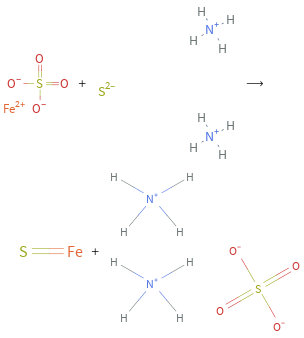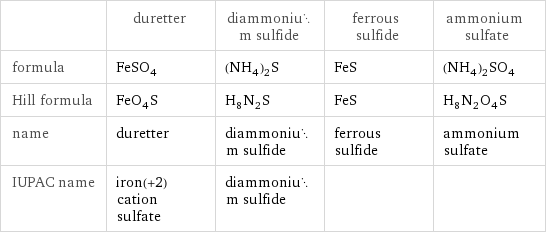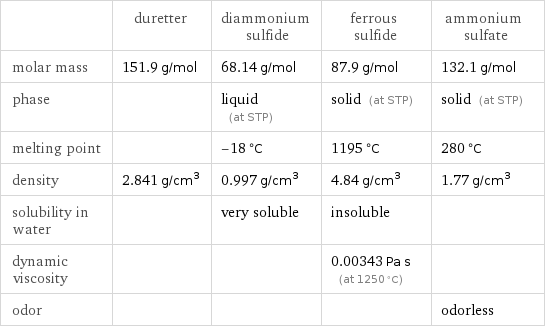Input interpretation

FeSO_4 duretter + (NH_4)_2S diammonium sulfide ⟶ FeS ferrous sulfide + (NH_4)_2SO_4 ammonium sulfate
Balanced equation

Balance the chemical equation algebraically: FeSO_4 + (NH_4)_2S ⟶ FeS + (NH_4)_2SO_4 Add stoichiometric coefficients, c_i, to the reactants and products: c_1 FeSO_4 + c_2 (NH_4)_2S ⟶ c_3 FeS + c_4 (NH_4)_2SO_4 Set the number of atoms in the reactants equal to the number of atoms in the products for Fe, O, S, H and N: Fe: | c_1 = c_3 O: | 4 c_1 = 4 c_4 S: | c_1 + c_2 = c_3 + c_4 H: | 8 c_2 = 8 c_4 N: | 2 c_2 = 2 c_4 Since the coefficients are relative quantities and underdetermined, choose a coefficient to set arbitrarily. To keep the coefficients small, the arbitrary value is ordinarily one. For instance, set c_1 = 1 and solve the system of equations for the remaining coefficients: c_1 = 1 c_2 = 1 c_3 = 1 c_4 = 1 Substitute the coefficients into the chemical reaction to obtain the balanced equation: Answer: | | FeSO_4 + (NH_4)_2S ⟶ FeS + (NH_4)_2SO_4
Structures

+ ⟶ +
Names

duretter + diammonium sulfide ⟶ ferrous sulfide + ammonium sulfate
Equilibrium constant
![Construct the equilibrium constant, K, expression for: FeSO_4 + (NH_4)_2S ⟶ FeS + (NH_4)_2SO_4 Plan: • Balance the chemical equation. • Determine the stoichiometric numbers. • Assemble the activity expression for each chemical species. • Use the activity expressions to build the equilibrium constant expression. Write the balanced chemical equation: FeSO_4 + (NH_4)_2S ⟶ FeS + (NH_4)_2SO_4 Assign stoichiometric numbers, ν_i, using the stoichiometric coefficients, c_i, from the balanced chemical equation in the following manner: ν_i = -c_i for reactants and ν_i = c_i for products: chemical species | c_i | ν_i FeSO_4 | 1 | -1 (NH_4)_2S | 1 | -1 FeS | 1 | 1 (NH_4)_2SO_4 | 1 | 1 Assemble the activity expressions accounting for the state of matter and ν_i: chemical species | c_i | ν_i | activity expression FeSO_4 | 1 | -1 | ([FeSO4])^(-1) (NH_4)_2S | 1 | -1 | ([(NH4)2S])^(-1) FeS | 1 | 1 | [FeS] (NH_4)_2SO_4 | 1 | 1 | [(NH4)2SO4] The equilibrium constant symbol in the concentration basis is: K_c Mulitply the activity expressions to arrive at the K_c expression: Answer: | | K_c = ([FeSO4])^(-1) ([(NH4)2S])^(-1) [FeS] [(NH4)2SO4] = ([FeS] [(NH4)2SO4])/([FeSO4] [(NH4)2S])](../image_source/4958c5085b7f0b40fe8af922bd97ecdc.png)
Construct the equilibrium constant, K, expression for: FeSO_4 + (NH_4)_2S ⟶ FeS + (NH_4)_2SO_4 Plan: • Balance the chemical equation. • Determine the stoichiometric numbers. • Assemble the activity expression for each chemical species. • Use the activity expressions to build the equilibrium constant expression. Write the balanced chemical equation: FeSO_4 + (NH_4)_2S ⟶ FeS + (NH_4)_2SO_4 Assign stoichiometric numbers, ν_i, using the stoichiometric coefficients, c_i, from the balanced chemical equation in the following manner: ν_i = -c_i for reactants and ν_i = c_i for products: chemical species | c_i | ν_i FeSO_4 | 1 | -1 (NH_4)_2S | 1 | -1 FeS | 1 | 1 (NH_4)_2SO_4 | 1 | 1 Assemble the activity expressions accounting for the state of matter and ν_i: chemical species | c_i | ν_i | activity expression FeSO_4 | 1 | -1 | ([FeSO4])^(-1) (NH_4)_2S | 1 | -1 | ([(NH4)2S])^(-1) FeS | 1 | 1 | [FeS] (NH_4)_2SO_4 | 1 | 1 | [(NH4)2SO4] The equilibrium constant symbol in the concentration basis is: K_c Mulitply the activity expressions to arrive at the K_c expression: Answer: | | K_c = ([FeSO4])^(-1) ([(NH4)2S])^(-1) [FeS] [(NH4)2SO4] = ([FeS] [(NH4)2SO4])/([FeSO4] [(NH4)2S])
Rate of reaction
![Construct the rate of reaction expression for: FeSO_4 + (NH_4)_2S ⟶ FeS + (NH_4)_2SO_4 Plan: • Balance the chemical equation. • Determine the stoichiometric numbers. • Assemble the rate term for each chemical species. • Write the rate of reaction expression. Write the balanced chemical equation: FeSO_4 + (NH_4)_2S ⟶ FeS + (NH_4)_2SO_4 Assign stoichiometric numbers, ν_i, using the stoichiometric coefficients, c_i, from the balanced chemical equation in the following manner: ν_i = -c_i for reactants and ν_i = c_i for products: chemical species | c_i | ν_i FeSO_4 | 1 | -1 (NH_4)_2S | 1 | -1 FeS | 1 | 1 (NH_4)_2SO_4 | 1 | 1 The rate term for each chemical species, B_i, is 1/ν_i(Δ[B_i])/(Δt) where [B_i] is the amount concentration and t is time: chemical species | c_i | ν_i | rate term FeSO_4 | 1 | -1 | -(Δ[FeSO4])/(Δt) (NH_4)_2S | 1 | -1 | -(Δ[(NH4)2S])/(Δt) FeS | 1 | 1 | (Δ[FeS])/(Δt) (NH_4)_2SO_4 | 1 | 1 | (Δ[(NH4)2SO4])/(Δt) (for infinitesimal rate of change, replace Δ with d) Set the rate terms equal to each other to arrive at the rate expression: Answer: | | rate = -(Δ[FeSO4])/(Δt) = -(Δ[(NH4)2S])/(Δt) = (Δ[FeS])/(Δt) = (Δ[(NH4)2SO4])/(Δt) (assuming constant volume and no accumulation of intermediates or side products)](../image_source/133139b51d9fc0c49652781f563491c4.png)
Construct the rate of reaction expression for: FeSO_4 + (NH_4)_2S ⟶ FeS + (NH_4)_2SO_4 Plan: • Balance the chemical equation. • Determine the stoichiometric numbers. • Assemble the rate term for each chemical species. • Write the rate of reaction expression. Write the balanced chemical equation: FeSO_4 + (NH_4)_2S ⟶ FeS + (NH_4)_2SO_4 Assign stoichiometric numbers, ν_i, using the stoichiometric coefficients, c_i, from the balanced chemical equation in the following manner: ν_i = -c_i for reactants and ν_i = c_i for products: chemical species | c_i | ν_i FeSO_4 | 1 | -1 (NH_4)_2S | 1 | -1 FeS | 1 | 1 (NH_4)_2SO_4 | 1 | 1 The rate term for each chemical species, B_i, is 1/ν_i(Δ[B_i])/(Δt) where [B_i] is the amount concentration and t is time: chemical species | c_i | ν_i | rate term FeSO_4 | 1 | -1 | -(Δ[FeSO4])/(Δt) (NH_4)_2S | 1 | -1 | -(Δ[(NH4)2S])/(Δt) FeS | 1 | 1 | (Δ[FeS])/(Δt) (NH_4)_2SO_4 | 1 | 1 | (Δ[(NH4)2SO4])/(Δt) (for infinitesimal rate of change, replace Δ with d) Set the rate terms equal to each other to arrive at the rate expression: Answer: | | rate = -(Δ[FeSO4])/(Δt) = -(Δ[(NH4)2S])/(Δt) = (Δ[FeS])/(Δt) = (Δ[(NH4)2SO4])/(Δt) (assuming constant volume and no accumulation of intermediates or side products)
Chemical names and formulas

| duretter | diammonium sulfide | ferrous sulfide | ammonium sulfate formula | FeSO_4 | (NH_4)_2S | FeS | (NH_4)_2SO_4 Hill formula | FeO_4S | H_8N_2S | FeS | H_8N_2O_4S name | duretter | diammonium sulfide | ferrous sulfide | ammonium sulfate IUPAC name | iron(+2) cation sulfate | diammonium sulfide | |
Substance properties

| duretter | diammonium sulfide | ferrous sulfide | ammonium sulfate molar mass | 151.9 g/mol | 68.14 g/mol | 87.9 g/mol | 132.1 g/mol phase | | liquid (at STP) | solid (at STP) | solid (at STP) melting point | | -18 °C | 1195 °C | 280 °C density | 2.841 g/cm^3 | 0.997 g/cm^3 | 4.84 g/cm^3 | 1.77 g/cm^3 solubility in water | | very soluble | insoluble | dynamic viscosity | | | 0.00343 Pa s (at 1250 °C) | odor | | | | odorless
Units
